电子科技大学:《DSP算法实现技术与架构 VLSI Digital Signal Processing Systems Design and Implementation》课程教学资源(课件讲稿)Chapter 05 展开 Unfolding
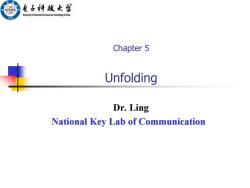
电子科披女学 Uaiversity of Electreaie Selence and Techaolopof Chiaa Chapter 5 Unfolding Dr.Ling National Key Lab of Communication
Chapter 5 Unfolding Dr. Ling National Key Lab of Communication
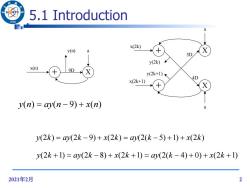
5.1 Introduction /96 a x(2k) y(n) a 5D, y(2k) x(n) 9D y(2k+1)K 4D x(2k+1) y(n)=ay(n-9)+x(n) a y(2k)=ay(2k-9)+x(2k)=y(2(k-5)+1)+x(2k) y(2k+1)=ay(2k-8)+x(2k+1)=ay(2(k-4)+0)+x(2k+1) 2021年2月 2
2021年2月 2 5.1 Introduction + X x(n) y(n) a 9D + + X X a a 4D 5D x(2k+1) x(2k) y(2k+1) y(2k) y(n) ay(n 9) x(n) y(2k 1) ay(2k 8) x(2k 1) ay(2(k 4) 0) x(2k 1) y(2k) ay(2k 9) x(2k) ay(2(k 5) 1) x(2k)

Unfolding? 96 1. Unfolding is a transformation technique that can be applied to a DSP program to create a new program describing more than one iteration of the original program. 2. Unfolding creates a new programs that describes J consecutive iterations of the original program. 3.Unfolding can be used to reduce sample period and create parallel processing. 2021年2月 3
2021年2月 3 Unfolding? 1. Unfolding is a transformation technique that can be applied to a DSP program to create a new program describing more than one iteration of the original program. 2. Unfolding creates a new programs that describes J consecutive iterations of the original program. 3. Unfolding can be used to reduce sample period and create parallel processing
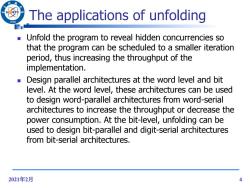
The applications of unfolding 96 Unfold the program to reveal hidden concurrencies so that the program can be scheduled to a smaller iteration period,thus increasing the throughput of the implementation. Design parallel architectures at the word level and bit level.At the word level,these architectures can be used to design word-parallel architectures from word-serial architectures to increase the throughput or decrease the power consumption.At the bit-level,unfolding can be used to design bit-parallel and digit-serial architectures from bit-serial architectures. 2021年2月 4
2021年2月 4 The applications of unfolding Unfold the program to reveal hidden concurrencies so that the program can be scheduled to a smaller iteration period, thus increasing the throughput of the implementation. Design parallel architectures at the word level and bit level. At the word level, these architectures can be used to design word-parallel architectures from word-serial architectures to increase the throughput or decrease the power consumption. At the bit-level, unfolding can be used to design bit-parallel and digit-serial architectures from bit-serial architectures

5.2 Unfolding algorithm 95 The J unfolded program contains J times as many nodes and edges as the original DFG. For each node U in the original DFG,draw the J nodes Uo,U,...,U-1. s For each edge U->V with w delays in the original FG,draw the edges U withdelays fori=0,1,..,J-1. 2021年2月 5
2021年2月 5 5.2 Unfolding algorithm The J unfolded program contains J times as many nodes and edges as the original DFG. For each node U in the original DFG, draw the J nodes U0 ,U1 ,…,UJ-1 . For each edge UV with w delays in the original DFG, draw the J edges UiV(i+w)%J with delays for i=0,1,…,J-1. J i w J i w
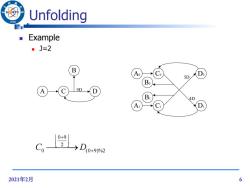
U Unfolding Example ■J=2 B Ao Co Do 5D Bo A 9D Br 4D A D 0+9 L2→D0+92 2021年2月 6
2021年2月 6 Unfolding Example J=2 C 9D D B A C0 4D 5D C1 D0 D1 B1 B0 A1 A0 0 9 2 C D 0 (0 9)%2

U Unfolding Example ■J=4 Uo 37D 10D U V 9D U 9D U2 1+37 9D U: 2021年2月 7
2021年2月 7 Unfolding Example J=4 U V 37D U0 V3 V2 V1 V0 U3 U2 U1 9D 10D 9D 9D 1 37 4 U V 1 (1 37)%4

Unfolding Example ■]=3 2D D 2D U Uo 2D 5D 6D D T 2D U U: 2D D 2021年2月 8
2021年2月 8 Unfolding Example J=3 U V T 5D 6D D U0 U2 U1 V0 V2 V1 T0 T2 T1 2D 2D 2D 2D 2D D D 1 (1) l i,k 1 (1) l i,k
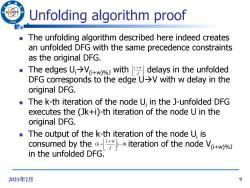
Unfolding algorithm proof 295 The unfolding algorithm described here indeed creates an unfolded DFG with the same precedence constraints as the original DFG. The edges UV(i+w)%with delays in the unfolded DFG corresponds to the edge U>V with w delay in the original DFG. The k-th iteration of the node U:in the J-unfolded DFG executes the (Jk+i)-th iteration of the node U in the original DFG. The output of the k-th iteration of the node U is consumed by the iteration of the node V in the unfolded DFG. 2021年2月 9
2021年2月 9 Unfolding algorithm proof The unfolding algorithm described here indeed creates an unfolded DFG with the same precedence constraints as the original DFG. The edges UiV(i+w)%J with delays in the unfolded DFG corresponds to the edge UV with w delay in the original DFG. The k-th iteration of the node Ui in the J-unfolded DFG executes the (Jk+i)-th iteration of the node U in the original DFG. The output of the k-th iteration of the node Ui is consumed by the iteration of the node V(i+w)%J in the unfolded DFG. J i w th J i w k ( )
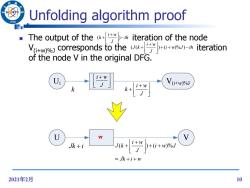
Unfolding algorithm proof The output of the iteration of the node Vw corresponds to the iteration of the node V in the original DFG. U: i+w V(itw)J k k+ U V Jk+i J++6+m% =Jk+i+w 2021年2月 10
2021年2月 10 Unfolding algorithm proof The output of the iteration of the node V(i+w)%J corresponds to the iteration of the node V in the original DFG. th J i w k ( ) i w J th J i w J k ( ( ) ( )% ) Ui U V(i+w)%J i w J k i w k J ? Jk i ( ) ( )% i w J k i w J J Jk i w w V
按次数下载不扣除下载券;
注册用户24小时内重复下载只扣除一次;
顺序:VIP每日次数-->可用次数-->下载券;
- 电子科技大学:《DSP算法实现技术与架构 VLSI Digital Signal Processing Systems Design and Implementation》课程教学资源(课件讲稿)Chapter 04 重定时 Retiming.pdf
- 电子科技大学:《DSP算法实现技术与架构 VLSI Digital Signal Processing Systems Design and Implementation》课程教学资源(课件讲稿)Chapter 03 流水与并行 Pipelining and Parallel Processing.pdf
- 电子科技大学:《DSP算法实现技术与架构 VLSI Digital Signal Processing Systems Design and Implementation》课程教学资源(课件讲稿)Chapter 02 迭代界 Iteration Bound.pdf
- 电子科技大学:《DSP算法实现技术与架构 VLSI Digital Signal Processing Systems Design and Implementation》课程教学资源(课件讲稿)Chapter 01 导论 Introduction to Digital Signal Processing Systems.pdf
- 电子科技大学:《DSP算法实现技术与架构 VLSI Digital Signal Processing Systems Design and Implementation》课程教学资源(课件讲稿)Chapter 00 简介 Introduction to VLSI(凌翔).pdf
- 电子科技大学:《DSP算法实现技术与架构 VLSI Digital Signal Processing Systems Design and Implementation》课程教学资源(教学大纲,凌翔).pdf
- 电子科技大学:《电子无源元件工艺实验》课程实验课件讲稿 Electronic Passive Components Process Experiment Course(主讲:戴丽萍).pdf
- 电子科技大学:《半导体封装测试与可靠性 Packaging,Testing and Reliability of Semiconductor》课程教学资源(课件讲稿,思政版).pdf
- 电子科技大学:《半导体封装测试与可靠性 Packaging,Testing and Reliability of Semiconductor》课程教学资源(教学大纲,思政版).pdf
- 电子科技大学:《ASIC设计 Application Specific Integrated Circuit Design》课程教学资源(课件讲稿)Topic 4 VLSI for DSP.pdf
- 电子科技大学:《ASIC设计 Application Specific Integrated Circuit Design》课程教学资源(课件讲稿)Topic 3 Verification and Test.pdf
- 电子科技大学:《ASIC设计 Application Specific Integrated Circuit Design》课程教学资源(课件讲稿)Topic 2.2 FPGA Design with Verilog(Supplementary).pdf
- 电子科技大学:《ASIC设计 Application Specific Integrated Circuit Design》课程教学资源(课件讲稿)Topic 2.1 FPGA Design with Verilog(FPGA Design Method、Design Examples).pdf
- 电子科技大学:《ASIC设计 Application Specific Integrated Circuit Design》课程教学资源(课件讲稿)Topic 1.3 Introduction-Our Course.pdf
- 电子科技大学:《ASIC设计 Application Specific Integrated Circuit Design》课程教学资源(课件讲稿)Topic 1.2 Introduction-ASIC Design.pdf
- 电子科技大学:《ASIC设计 Application Specific Integrated Circuit Design》课程教学资源(课件讲稿)Topic 1.1 Introduction-IC technology.pdf
- 电子科技大学:《现代网络理论与综合 Theory and Synthesize of Electric Network》课程教学资源(课件讲稿)第20讲 高阶有源滤波器.pdf
- 电子科技大学:《现代网络理论与综合 Theory and Synthesize of Electric Network》课程教学资源(课件讲稿)第19讲 有源滤波器.pdf
- 电子科技大学:《现代网络理论与综合 Theory and Synthesize of Electric Network》课程教学资源(课件讲稿)第9讲 信号流图分析法.pdf
- 电子科技大学:《现代网络理论与综合 Theory and Synthesize of Electric Network》课程教学资源(课件讲稿)第6讲 网络函数拓扑法.pdf
- 电子科技大学:《DSP算法实现技术与架构 VLSI Digital Signal Processing Systems Design and Implementation》课程教学资源(课件讲稿)Chapter 06 折叠 Folding.pdf
- 电子科技大学:《DSP算法实现技术与架构 VLSI Digital Signal Processing Systems Design and Implementation》课程教学资源(课件讲稿)Chapter 07 脉动阵列 Systolic Architecture.pdf
- 电子科技大学:《DSP算法实现技术与架构 VLSI Digital Signal Processing Systems Design and Implementation》课程教学资源(课件讲稿)Chapter 10 递归滤波器 Pipelined and Parallel Recursive and Adaptive Filters.pdf
- 电子科技大学:《DSP算法实现技术与架构 VLSI Digital Signal Processing Systems Design and Implementation》课程教学资源(课件讲稿)Chapter 08 快速卷积 Fast Convolution.pdf
- 电子科技大学:《DSP算法实现技术与架构 VLSI Digital Signal Processing Systems Design and Implementation》课程教学资源(课件讲稿)Chapter 09 算法强度缩减 Algorithmic strength reduction in filters and transforms.pdf
- 电子科技大学:《DSP算法实现技术与架构 VLSI Digital Signal Processing Systems Design and Implementation》课程教学资源(课件讲稿)Chapter 11 缩放噪声 Scaling and Roundoff Noise.pdf
- 电子科技大学:《DSP算法实现技术与架构 VLSI Digital Signal Processing Systems Design and Implementation》课程教学资源(课件讲稿)Chapter 13 位级运算 Bit-Level Arithmetic Architectures.pdf
- 电子科技大学:《DSP算法实现技术与架构 VLSI Digital Signal Processing Systems Design and Implementation》课程教学资源(课件讲稿)Chapter 14 冗余运算 Redundant Arithmetic.pdf
- 电子科技大学:《DSP算法实现技术与架构 VLSI Digital Signal Processing Systems Design and Implementation》课程教学资源(课件讲稿)Chapter 15 数字强度缩减 Numerical Strength Reduction.pdf
- 电子科技大学:《集成电路可测性设计 VLSIDesign》课程教学资源(课件讲稿)第1章 概述——研究意义(王忆文).pdf
- 电子科技大学:《集成电路可测性设计 VLSIDesign》课程教学资源(课件讲稿)第1章 概述——测试的基本知识.pdf
- 电子科技大学:《集成电路可测性设计 VLSIDesign》课程教学资源(课件讲稿)第2章 电路测试基础.pdf
- 电子科技大学:《集成电路可测性设计 VLSIDesign》课程教学资源(课件讲稿)第3章 验证、模拟和仿真.pdf
- 电子科技大学:《集成电路可测性设计 VLSIDesign》课程教学资源(课件讲稿)第4章 自动测试生成.pdf
- 电子科技大学:《集成电路可测性设计 VLSIDesign》课程教学资源(课件讲稿)第10章 电流测试.pdf
- 电子科技大学:《集成电路可测性设计 VLSIDesign》课程教学资源(课件讲稿)第11章 存储器测试.pdf
- 电子科技大学:《集成电路可测性设计 VLSIDesign》课程教学资源(课件讲稿)第12章 Soc测试(1/2).pdf
- 电子科技大学:《集成电路可测性设计 VLSIDesign》课程教学资源(课件讲稿)第5章 专用可测性设计.pdf
- 电子科技大学:《集成电路可测性设计 VLSIDesign》课程教学资源(课件讲稿)第6章 扫描设计.pdf
- 电子科技大学:《集成电路可测性设计 VLSIDesign》课程教学资源(课件讲稿)第7章 边界扫描.pdf
